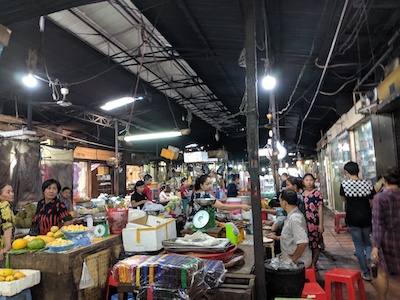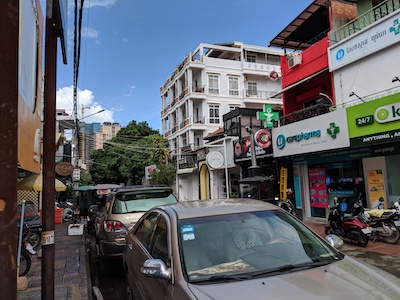First Impressions
I'm currently writing from a highly air-conditioned room on the fourth floor of the Cambodian building that houses the offices of Open Development Cambodia. The first week of my internship has come and gone and I feel as though I’ve already experienced so much. I’ve begun my research with ODC and am exploring and (slowly) adapting to the local culture.

No matter how you go, the flights to Phnom Penh take over 24 hours, and frequently more. I arrived last Friday, just in time to experience one of the intense thunderstorms that breaks over the city every afternoon. Stepping from the air-conditioned world of international airports into Phnom Penh’s rush hour was, needless to say, an intense culture shock. Even having researched the city I was unprepared for the numbers of tuk tuks and motorbikes surging through the streets. Much has been said about the traffic of southeast Asian cities, and while Phnom Penh isn’t nearly on the scale of Bangkok or Hanoi, the similarity of their traffic might fool you.
The Phnom Penh I’ll be living in for the next ten weeks really does remind me of a smaller version of one of those massive cities. The traffic never quite stops, the streets are lined with stalls selling everything from roasted meat to smartphones, and increasing foreign investment is raising living standards (and prices). However, so far I’ve gotten the impression that the city retains the friendliness and community of a smaller city, and that its residents like it that way.

It certainly hasn’t always been that way. Cambodia is very much still in recovery from the devastation of the Khmer Rouge period from 1975 to 1978, and the long period of questionable leadership afterwards. As part of my work, which I’ll detail more in later posts, I’ll be researching potential avenues for sustainable development in the country, as well as the challenges Cambodia faces. As part of that work, I’ve spent most of the last week learning about the country’s recent development.

It’s generally understood that southeast Asian countries have trended towards rapid development over the past few decades, but it’s difficult to appreciate what that has meant for the average person until you’re here on the ground, speaking with people who experienced those changes firsthand. I saw a photograph of the city skyline from 2014, with only 3 or 4 tall skyscrapers visible. Today there are dozens in the center of the city alone. Going further back, a local here told me that up until the 1990s, there were very few paved roads in the entire country, something almost unbelievable now given that most of the city is paved over.
I’ve been told that the rural areas outside Phnom Penh haven’t changed quite as much, and I’m looking forward to seeing that for myself, but even slower changes must have led to a remarkable difference in the standard of living for most people in this country.
From a development perspective, one of the big changes for Cambodia in recent years has been moving from a low-income country to a lower-middle income country in the World Bank’s classification scheme. That change has a whole host of implications that I’ll talk about in later posts, but ultimately it means the economy here is growing. However, that doesn’t necessarily mean that all Cambodians are included in that growth, and figuring out how further development can be more equitably shared between all Cambodians is going to be one of the main focuses of my work here.
In my next few blogs I’ll go into more detail about my research with Open Development Cambodia, and the value of their mission to make development data available to the public.